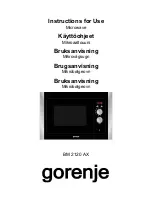
en
Tested for you in our cooking studio
50
Allowing the dough to prove at dough
proving setting
Yeast dough will prove considerably more quickly using
the "Dough proving" heating type than at room
temperature and does not dry out. Only start operation
when the cooking compartment has fully cooled down.
Always allow yeast dough to prove twice. Observe the
specifications in the settings tables for the 1st and 2nd
proving processes (dough fermentation and final
fermentation).
Dough fermentation
Pour 200 ml water onto the cooking compartment floor
for the dough fermentation.
Caution!
Surface damage
■
Never pour water into the hot cooking compartment.
The temperature change can cause damage to the
enamel.
■
Do not use distilled water. Use tap water only.
Place the dough into a heat-resistant bowl and place it
onto the wire rack. Use the settings indicated in the
table.
Do not open the appliance door during the proving
process, as moisture will escape. Do not cover the
dough.
Condensation builds during operation which steams up
the door pane. Wipe out the cooking compartment after
dough proving. Loosen any limescale with a little
vinegar and wipe with clean water.
Final fermentation
Place your baked item into the oven at the shelf position
indicated in the table.
If you want to preheat the oven, the final fermentation
takes place outside the appliance in a warm place.
Recommended setting values
The temperature and proving time are dependent on
the type and quantity of the ingredients. The values in
the table are therefore only meant to be average values.
Type of heating used:
■
Œ
Dough proving
Defrosting
Use heating type "CircoTherm" to defrost frozen fruit,
vegetables and baked items. Poultry, meat and fish
should ideally be defrosted in the refrigerator.
Use the following shelf positions when defrosting:
■
1 wire rack: Level 2
■
2 wire racks: Level 3+1
Recommended setting values
The times in the table are average values. They are
dependent on the quality, freezing temperature (-18 °C)
and composition of the food. Time ranges are indicated.
Set the shortest time first and then extend the time if
necessary.
Tip:
Items which were frozen flat or portioned defrost
faster than those frozen in a block.
Remove frozen food from the packaging and place it in
suitable cookware onto the wire rack.
Stir the food or turn it once or twice in between. Large
pieces of food should be turned several times.
Occasionally split the food or remove items which have
already defrosted from the cooking compartment.
Vegetables, e.g. cucumbers
1-litre preserving jars
1
‚
160-170
Before it starts bubbling: 30-40
-
Residual heat: 30
Stone fruit, e.g. cherries, damsons 1-litre preserving jars
1
‚
160-170
Before it starts bubbling:30-40
-
Residual heat:35
Pomes, e.g. apples, strawberries
1-litre preserving jars
1
‚
160-170
Before it starts bubbling:30-40
-
Residual heat: 25
Preserving
Cookware
Shelf posi-
tion
Type of
heating
Tempera-
ture in °C
Cooking time in mins.
Dish
Accessories/cookware
Shelf posi-
tion
Type of
heating
Step
Tempera-
ture in °C
Cooking
time in
mins.
Yeast dough, light
Bowl
2
Œ
Dough fer-
mentation
35-40
25-30
Baking tray
2
Œ
Final fermen-
tation
35-40
10-20
Yeast dough, heavy and rich
Bowl
2
Œ
Dough fer-
mentation
35-40
20-40
Baking tray
2
Œ
Final fermen-
tation
35-40
15-25
Summary of Contents for B57CR25 0 Series
Page 1: ...en INSTRUCTION MANUAL BUILT IN OVEN B57CR25 0...
Page 2: ......
Page 53: ...6...
Page 54: ...6...
Page 55: ...6...







































